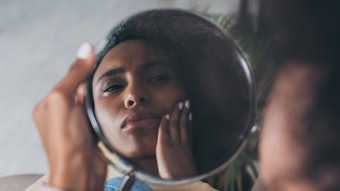
Read the full version in the digital edition of C&T magazine.
Healthy skin has its own rhythm and flow, with defense and repair mechanisms attuned to the circadian cycle of day and night renewing skin like clockwork. Disrupting this flow, e.g., by artificial blue light at night, however, can have negative consequences on the skin’s machinery. Nadine Pernodet, Ph.D. (NP), senior vice president, Biosciences, R&D for The Estée Lauder Cos., explains these dynamics in the following excerpt adapted from an interview.
C&T: What do we know about the effects of natural and artificial blue light in skin?
NP: Protection during daytime and repair during nighttime are essential for keeping a healthy working skin. In terms of blue light and light pollution, these have been well-studied in the medical field and are understood to disrupt our natural circadian rhythm, but not as much research has been done in skin. At The Estée Lauder Cos., we are always looking for factors that might impact critical mechanisms in the skin. Nine years ago, we began to explore the effects of blue light and light pollution on the skin’s alignment with the circadian rhythm.
When we saw the research presented at different medical conferences about the impact of blue light and blue light from devices — showing that in the body, it can inhibit melatonin release and therefore directly affect sleep, affecting the ability to build memory during nighttime; the ability to learn, especially in children; and it can directly affect the eyes, with diseases usually seen in 50 to 60 year-olds appearing in younger adults 30 to 40 years old — we recognized clues that blue light could also very well impact skin and skin behavior.
This is why we started research in this area. Of course, at the time, we were not sure that skin cells could directly sense blue light; that was a big question mark. We built a blue light chamber where we could expose not biopsies, but skin cells directly, to see if they could sense the presence of light, more specifically blue light, and control their own behavior to align (or not) with this rhythm. It was a huge discovery finding that the skin knows when there is a presence of light or when it is dark, and therefore can control its activities, switching to daytime functions when light and nighttime functions when dark.
This makes sense because skin is directly exposed to the environment and to light, and it has receptors that are actually the same as those that are present in the eyes — opsin receptors. This was a clue that skin cells might be able to synchronize to daytime with light and to nighttime with darkness. We were the first to show this.
With our nights now being full of artificial light and blue light, skin cells think it is still daytime and therefore it puts many markers “out of whack,” causing a huge increase in damage. I want to emphasize, however, because we have been seeing many claims that blue light is generally “bad” that blue light is still essential during daytime. It is a critical cue for us to synchronize with daytime rhythm to be active. Yes, there are side effects of free radicals, but we have the right technologies to counteract them. Blue light at nighttime is when it is the worst, so again, we must be sure to have the technologies to establish this natural rhythm to optimize protection, repair damage and respect natural skin functions.
C&T: What are some of the mechanisms in skin during daytime versus nighttime?
NP: In the morning, the skin barrier is thicker to provide better protection from the environment while at nighttime, skin cells are being repaired and building proteins and lipids to strengthen the barrier. Additionally, skin has a higher pH to kill off some detrimental viruses or bacteria that could infect the skin. Skin also has a lower cellular proliferation rate in the daytime because to proliferate, skin cells must divide and in doing so, they must expose their DNA, which leaves them open to direct attack by UV. Highly damaged DNA could eventually bring about cell death, accelerated aging or worse, cause cancer.
During nighttime, skin’s temperature is higher, so the barrier is much more fluid and more permeable. Due to this, skin tends to lose moisture at night. In addition, a more permeable barrier may lead to an increase in irritation because the barrier is not as strong to keep things outside.
We have investigated the timing of repair functions of skin cells at night. In the early hours, cells first activate a mechanism called autophagy. Autophagy is responsible for removing damage that has accumulated during daytime. This process takes the proteins and lipids that have been damaged and turns them into building blocks for skin cells to use to build new proteins and lipids. Next, DNA repair increases and peaks, followed by cellular proliferation — cells cannot divide when there is DNA damage, so the repair must happen first. After cell proliferation is when the machinery is ready to produce all the new lipids and proteins in preparation for the next morning.
If these mechanisms were never disturbed, we would all have youthful, beautiful and new skin every morning, but this machinery gets disrupted by our modern lives. Our challenge is to develop and test new technologies that are then incorporated into our products to support the natural functions of skin so that damage gets repaired or removed before it contributes to visible signs of skin aging.
Read the full version in the digital edition of C&T magazine.











